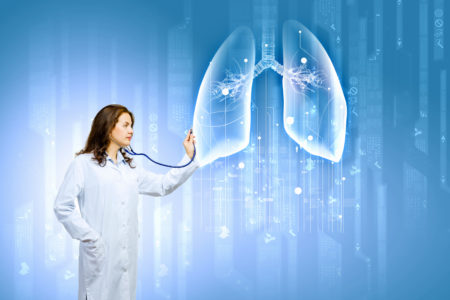Your Stage 3 COPD: Survive and Thrive is part of our The FLASS Summer COPD Guide 2019.
Florida Lung, Asthma and Sleep Specialists are here to help you show your lungs some love.

Florida Lung, Asthma and Sleep Specialists are here to help show your lungs some love.
The Guide is designed to discuss the basics of each stage of COPD. In the first two blogs, we began with definitions and care for the two mildest of the four stages of COPD. Pulmonologists named those two early stages, Stage I and Stage II. Likewise, in Part 3 of the FLASS Guide, we extended our discussion to capture some facts about the in-between stages of early COPD.
Now, in Part 4, our Summer of 2019 COPD Guide continues to describe Stage 3 and some of Stage 4 COPD expectations of care. And by the way, although we featured this guide in the summer of 2019, the details within the series of blogs contain basic useful information for the entire year—and beyond.
Your Stage 3 COPD Diagnosis
At this point, after Stage 1 and 2, as your COPD progresses, you are most probably a veteran of lung function testing.
You’ve experienced such as pulmonary function tests as spirometry and exercise tolerance testing. Before diagnosing you with Stage 3 COPD, your pulmonologist will perform more of those types of tests as well as take a detailed medical history.
During your FLASS consultation, your pulmonologist or health care provider will interview you and discuss how your COPD affects your life. If you’re in stage 3 COPD, you’re likely experiencing significant symptoms. You will probably discuss changes in your not only in your respiratory health but in your overall physical condition.
Diagnosis of Stage 3 COPD
Determining stage 3 COPD is similar to determining stage 1 and stage 2 COPD. Your doctor may use the GOLD System and the BODE Index to categorize your stage of COPD.
In the GOLD System, stage 3 COPD is categorized as severe COPD with a FEV1 (forced expiratory volume in one second) between 30 and 50 percent of normal lung capacity. Find out more about this test at this informative easy-to-read online resource.
We give you this figure because we want you to know your doctor has qualitative, objective ways to diagnose your condition. However, test data is a dry way to discuss the progression of this disease. Instead of tests and terminology, let’s look at your Stage Three COPD symptoms and discuss what you should expect as your disease progresses.
In this blog FLASS shares you the ways your Stage Three COPD symptoms might limit your life-style. Other tests can also determine what treatments will be next. For example, soon after the diagnosis of your stage 3 COPD, you might need to begin taking oxygen therapy You and your doctor will also monitor blood oxygen levels to prove to what degree your oxygen therapy helps your breathing condition.

In Stage 3 COPD, our motto is “Be Prepared,” for flare-ups.
Living With Stage 3 COPD
Learning the top six signals of worsening COPD helps you know what to expect as the disease progresses.
Now, let’s get more specific with the symptoms in stage III of COPD. First and foremost, you are bound to notice more pulmonary symptoms.
In stage 3 COPD, doctors refer to your pulmonary condition as significant lung function impairment.
Putting this in simple terms, you will experience more respiratory difficulty.
- In stage 3, you will experience flare-ups of respiratory symptoms more often.
- Undoubtedly more shortness of breath will begin to limit your activity.
- You will endure worse bouts of coughing with more mucus. This will begin to interrupt your lifestyle
- You will find yourself tiring more easily because it takes more effort and energy to breathe.
- Colds and flu might occur more often in your life, be easier to “catch” and harder to cure.
Alarming New Symptoms: You’ve Gone Beyond Stage 2 into Stage 3 COPD
New and somewhat alarming symptoms might surprise you. You might not realize why you are suffering swelling in ankles, legs, and feet. A stronger tightness in your chest might make you think there is something wrong with your heart.
Likewise, a faster heartbeat or bluish-gray lips and fingernails could signal COPD is progressing. You might even need immediate or emergency medical care for these symptoms as well as extreme shortness of breath or loss of consciousness.
Sometimes these symptoms are subtle. You notice, for example, that you get breathless from simply dressing or undressing. Talking steadily or catching your breath in the summer heat, air conditioning or winter cold might give you serious difficulty.
You will see a new level of tiredness or fatigue even when you are doing favorite activities you love. And you will definitely learn that this symptom does not mean you cease exercise.
An Introduction to Treatments in Stage Three COPD

In Your Stage 3 COPD, you might require oxygen treatments.
As mentioned above you might require oxygen. You might inhale it through either through a mask or small tubes (termed nasal cannula) that sit inside your nose. This will be especially important during certain times when you are enduring severe feelings of breathlessness.
Your physician might continue or change or increase dosages of bronchodilators. As you realized in Stage 2, these medications make breathing easier.
Following The FLASS COPD Action Plan
Your FLASS team will prepare a pulmonary rehabilitation plan with advice on exercise, lifestyle issues, steroid therapy, and antibiotic therapy is prepared during this time.
You might not realize it, but weight loss can become a problem during stage three. Often the extreme fatigue brings about a loss of appetite.
And if you are eating and not getting enough nutrients from how you’re eating, your symptoms may worsen from the stress. We’ll bring you more information about this in our next blog, as we inform you of ways to cope with hope despite the progression of this disease.
Terrific Take-Aways Concerning Your Stage 3 COPD
As you enter the more serious stages of COPD, one of the biggest tips from FLASS is “Be prepared.” Be sure to have your phone and medicines handy in case you have a serious flare-up. Your Stage 3 COPD signals the necessity of being ready for any emergency.
You can also minimize your ER visits by being certain you have your doctor and hospital phone numbers available. We also remind you to keep your list of updated medicines handy, on a card or in your cell phone. This makes your ER visit easier. Just give your lists to the doctor or healthcare provider in charge of your treatment at the ER.
We promise to bring you more lifestyle tips to make it easier for you to survive and thrive in spite of your Stage 3 COPD. Learn more about how to handle your serious COPD Stages 3 and 4, in our next blog, Part 5 of your Summer 2019 COPD Guide.

